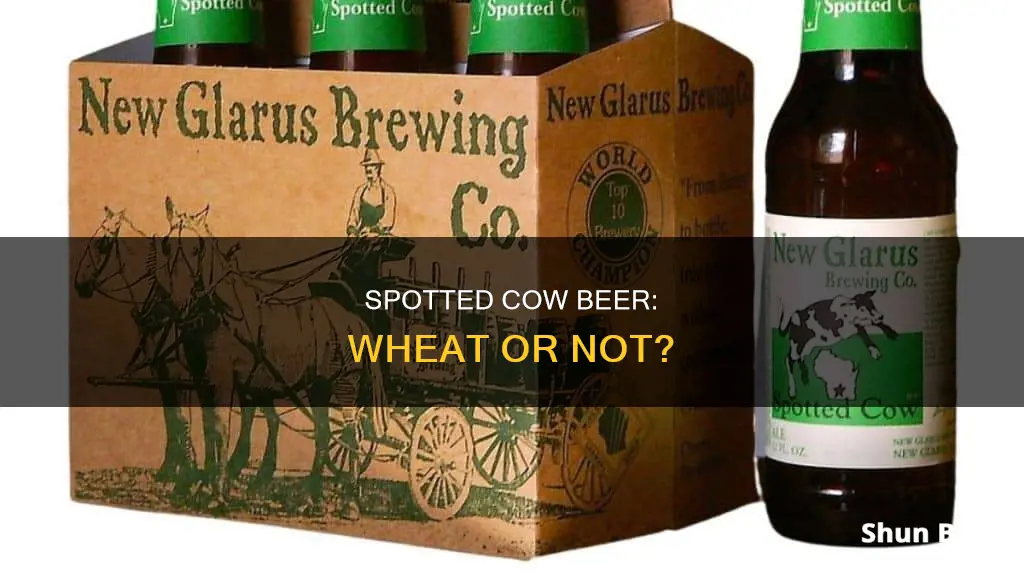
Spotted Cow is a cask-conditioned, unfiltered farmhouse ale with an ABV of 5.1%. It is brewed by the New Glarus Brewing Company in Wisconsin and is the best-selling craft beer in the state. Spotted Cow is a blend of Pilsner malt, white wheat, and caramel malt, with water from the brewery's own well. The beer is fermented with German ale yeast and features noble Saaz hops, which are collected annually in Europe. While it has often been labelled a cream ale, the brewmaster, Dan Carey, refers to it as a farmhouse ale.
| Characteristics | Values |
|---|---|
| ABV | 5.1% |
| Style | Farmhouse Ale, Cream Ale |
| Ingredients | Pilsner malt, white wheat, caramel malt, Saaz hops, German ale yeast, malted barley, water |
| Taste | Honey, orange peel, citrus, malt, hops, bready aftertaste |
| Calories | 150 |
| Carbohydrates | 37g |
What You'll Learn

Spotted Cow is a farmhouse ale, not an IPA
Farmhouse ale is an ancient European tradition where farmers brewed beer for consumption on the farm from their own grain. Farmhouse ales are typically brewed with light malt so as not to overwhelm the malt with other ingredients such as hops and spices. Spotted Cow, for example, is brewed with flaked barley and the finest Wisconsin malts. It also includes hops, yeast, and water.
The farmhouse ale category includes a variety of styles, such as saison, bière de garde, gueuze, or sahti. Beers in this category tend to have a funky flavor, like wet hay or earth, and a tart, crisp, and dry mouthfeel. Farmhouse ales are traditionally brewed in Belgium and France and were originally consumed during the summer by seasonal workers tending crops.
Spotted Cow is not an IPA. IPAs tend to be bitter beers that focus on the hop, whereas Spotted Cow has a complex taste that is fruity and earthy, with a mild sweetness. It is also less bitter than an IPA, with a smooth and satisfying flavor. Spotted Cow is a unique and legendary beer that has earned its popularity and awards.
The Wheat Beer Experience: Flavor, Aroma, and Taste
You may want to see also

It's made by New Glarus Brewing Co. in Wisconsin
Spotted Cow Beer is manufactured by the New Glarus Brewing Company in Wisconsin. The company was founded in 1993 by Deborah Carey as a gift for her husband, Daniel, an experienced diploma master brewer. The New Glarus Brewing Company is an independently owned craft brewery, whose products can only be found in Wisconsin. The company is the 15th largest craft brewer and 25th largest overall brewing company in the United States, by sales volume.
The New Glarus Brewing Company is located in New Glarus, Wisconsin, and is run by the enthusiastic couple, Daniel and Deb Carey, who have successfully combined business management and brewing professionalism. The company is committed to the artistry of crafting world-class beer and blends tradition, creativity, and boldness to produce an unmatched selection of local brews. The brewery is nestled on a hill overlooking the Wisconsin countryside and attracts visitors from all over the world.
Spotted Cow is the company's best-selling brand and was first brewed in 1997. It is a cask-conditioned farmhouse ale and is considered one of the most well-known beers in Wisconsin. The beer is a blend of Pilsner malt, white wheat, and caramel malt, and the water used comes from the company's own well. The noble Saaz hops are used and the beer is fermented with German ale yeast. Spotted Cow has an ABV of around 5.1% and has a typical fruity and earthy flavor of farmhouse ales. It pairs well with a variety of foods, especially barbecue and different types of cheese.
The name Spotted Cow was inspired by a trip the Careys took to England, where they saw fields of sheep. Deb Carey remarked that it would be funny to have a cow on a beer label, possibly inspired by the Holstein cows back home. The beer has achieved legendary status and has won several awards, including Best Drink in Wisconsin in 2009 by Bon Appetit magazine.
IPAs and Wheat Beers: What's the Connection?
You may want to see also

It's a blend of Pilsner malt, white wheat and caramel malt
Spotted Cow is a cask-conditioned, unfiltered farmhouse ale with an ABV of 5.1%. It is a blend of Pilsner malt, white wheat, and caramel malt. The beer is produced by the New Glarus Brewing Company in Wisconsin and has become the brewery's flagship beer.
The Pilsner malt in Spotted Cow provides a solid, honey-sweet, bready character to the beer. It forms the backbone of the beer's flavour profile, imparting a smooth, creamy mouthfeel and a subtle, consistent haze. The Pilsner malt is complemented by the addition of white wheat, which contributes to the beer's cloudy appearance and enhances the fullness of flavours. The white wheat can occupy up to 30% of the grain bill, showcasing its importance in the blend.
The caramel malt, on the other hand, adds depth and complexity to the beer. It provides a touch of sweetness, reminiscent of orange peel or citrus, creating a perfect balance between malt and hops. The blend of these three malts gives Spotted Cow its distinctive flavour and makes it a popular choice among beer enthusiasts.
The unique blend of Pilsner malt, white wheat, and caramel malt in Spotted Cow results in a beer that is both approachable and complex. It has a subtle fruitiness of peach, orange, apricot, and banana, with a mildly sweet and slightly sour finish. The beer is also noted for its fun, fruity, and satisfying character, making it a favourite among those who prefer their beers to be more forgiving and less overpowering than IPAs.
In addition to the malt blend, the water used in Spotted Cow comes from the brewery's own well and has a hard character. The hops are the finest noble Saaz hops, selected annually from Europe, and the beer is fermented with a German ale yeast, contributing to its overall distinctive flavour and aroma.
Wheat Beer Allergies: Understanding the Connection and Symptoms
You may want to see also

It's unfiltered and cask-conditioned
Spotted Cow is a cask-conditioned and unfiltered farmhouse ale. Cask-conditioned beer is draught beer that has been transferred into casks, carbonated, sealed, and undergoes a final fermentation in the cask. This process results in a gentler level of carbonation, a rounder mouthfeel, and a slightly more complex flavour and aromatic profile. It is often served at cellar temperature, around 55°F.
Cask-conditioned beer is also known as "real ale", a term coined by the Campaign for Real Ale (CAMRA). Real ale is unfiltered, unpasteurised, and served without the use of extraneous carbon dioxide. The yeast is still present and living in the container, and a slow process of secondary fermentation continues in the cask, allowing the beer to retain its natural carbonation.
Unfiltered beer usually has a slightly cloudy appearance and a more complex flavour and aromatic profile. Spotted Cow has a fruity and earthy flavour, with notes of honey, orange peel, citrus, and a balance of malt and hops. It has a bready aftertaste.
The process of cask conditioning and leaving the beer unfiltered gives Spotted Cow its unique characteristics and flavour profile, resulting in a beer that is fun, fruity, and satisfying.
Lagers and Wheat Beers: What's the Difference?
You may want to see also

It's inspired by what German settlers used to brew
Spotted Cow is a farmhouse ale manufactured by the New Glarus Brewing Company in Wisconsin. It is the best-selling craft beer in the state and has won several awards. The beer is a blend of Pilsner malt, white wheat, and caramel malt. The water used comes from the brewery's own well and the hops are noble Saaz hops fermented with German ale yeast. Spotted Cow has a fruity and earthy flavour, with a bready aftertaste.
The creator of Spotted Cow, Dan Carey, stated that the beer is inspired by a visit to a museum where he saw a German farmhouse with a beer bubbling on the stove, covered in cheesecloth. This led him to wonder how early German settlers in the 1850s brewed their beer. At the time, lagers and Pilsners were becoming popular, but it is likely that German immigrants were making ale, which was top-fermented and unfiltered. Carey set out to create a beer that those farmers would have enjoyed, using Pilsner malt, white wheat, caramel malt, water from the brewery's well, Saaz hops, and German ale yeast.
German immigrants played a significant role in the history of beer in the United States. In the mid-19th century, German immigrants brewed pale, effervescent lager in their kitchens, seeking a taste of home. German brewers grew the lager industry by aggressively promoting the drink to American palates and adopting new industrial technologies. By the mid-1870s, an estimated 4,000 German breweries had popped up around the country, becoming neighbourhood hubs in growing cities. German brewers also faced opposition due to anti-immigrant sentiment and temperance movements, but they persevered and lager became America's most popular libation.
Winter Wheat Stout: Blue Moon's Seasonal Specialty
You may want to see also







